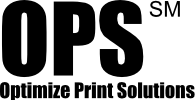About OPS
The OPS Assessment Process
1. Define Project Goals and Objectives
Gather information from key stakeholders, contacts and end users.
2. Collect Data
Next we install software on the network to map and record data on current assets, including all devices on the network and locally connected printers. Then we perform a walk thru of your office environment to map how your organization’s printer fleet is physically dispersed. OPS will provide visual representation of the user environment, so important to an effective design.
3. Analyze Details
We perform a detailed analysis taking the raw data that has been collected and using specialized software tools will determine the base line costs associated with your network printing, including: fixed costs, variable costs and areas to target for cost savings.
4. Provide Deliverable Documents
Based on your organization’s unique needs and goals, we will provide a deliverable document containing your current state and recommended print policy implementation plan.
5. Implement Optimization Plan
Now you can take control of your digital imaging fleet. Upon approval the OPS project Manager, working with key contacts, will begin the implementation process. Assigning tasks to key contacts required to maximize both immediate and long-term savings. Hold regularly scheduled project-status meetings to discuss open action items and next steps.
6. Verify Results
Using key performance indicators OPS will measure the success of the optimization implementation verifying stated goals have been met. We compare the starting baseline to the new state identifying the most successful policies and make additional changes if necessary.
Resources
- Brochure
- Sample
- FAQ
- Contact Us
